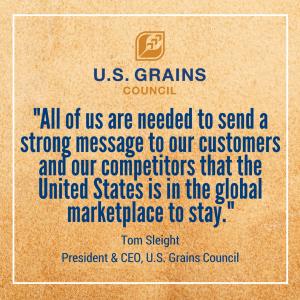By Tom Sleight, USGC President and CEO
Inattention, indifference and inaction are no longer options for those in agriculture with regard to our nation’s foreign policy. Just as producers must watch daily their weather, crop conditions and commodity prices, so too must they track policy developments around the world that will make or break the markets for the bountiful crops they are so efficient at producing.
Free trade has remained a key, philosophical driver for U.S. feed grains for decades, benefiting corn, barley and sorghum growers — among many other commodities. Now, agriculture must answer the call to defend trade and the rewards reaped from free trade-driven policies.
The upheaval of this philosophy is forcing U.S. agriculture into a defensive mode while challenging efforts for U.S. feed grains and co-products to continue expanding into markets old and new. We all must engage to help achieve conclusions in our trade negotiations that provide us and our customer’s long-term certainty and create a new platform for growth and integration of our regional and feed and fuel industries. This need extends far past one or two existing trade agreements and into the future of trade in developing markets around the world.
Of course, modernizing or examining the provisions within trade agreements is good business. But we must recognize agriculture is a traditional target for retaliation in trade disruptions, a clear and present danger. Members of the grain and feed industries must monitor trade policy negotiations in any sector with a careful eye. Farmers, members of the agriculture supply chain and negotiators alike must understand how important our markets — and trade — are to agriculture’s profitability.
Trade agreements are the key to opening markets and resolving tariff and nontariff barriers to allow the movement of coarse grains and co-products where they are demanded. We pride ourselves on feeding the world, but our inaction has hindered us while our trading partners and competitors alike surge forward.
We are no longer the only option for world grain demand. As a result, it is up to all of us in U.S. agriculture to make sure trade liberalization continues at all levels, lest we no longer will be the ones in the race, let alone winning.
The U.S. grains sector has significantly benefited from more liberalized trade in the past 30 years, and expanding access to export markets will continue to drive the success of American agriculture for years to come.
We in agriculture cannot afford to stay humble, silent observers. All of us are needed to send a strong message to our customers and our competitors that the United States is in the global marketplace to stay.
Editor’s note: The original version of this article appeared in Feed & Grain magazine’s Global Connection section and is condensed here in Global Update. Find the full version of the article here.


